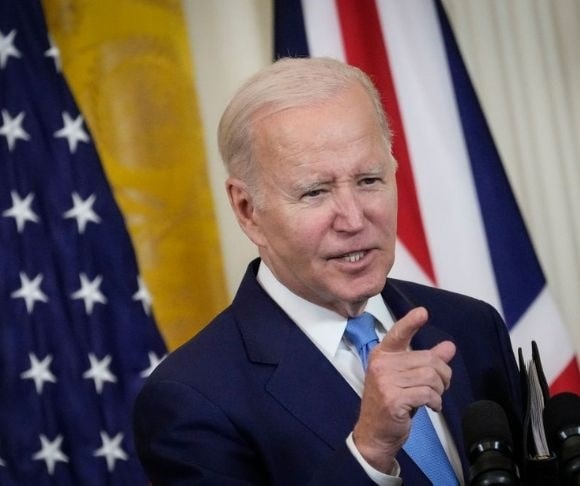A chief tenet of Bidenomics is to construct a breathing room. This is what President Joe Biden, Press Secretary Karine Jean-Pierre, and other White House officials have been saying for the past year while endorsing various public policy pursuits that only achieve more debt, deficits, distortions, and destruction for the US economy. Not a massive room, of course, but a little chamber, seemingly where the commander-in-chief can breathe into the occupant’s ear. Democrats are attempting to convince America that Bidenomics has succeeded – this time on the pages of The Wall Street Journal.
The Bidenomics Breathing Room
Is the US labor market “strong as hell,” as the president said of the economy while snacking on ice cream last year? The headline numbers show that the jobs arena is not crumbling as many economists had expected when the Federal Reserve shut off the printing press and started raising interest rates to their highest levels since before the global financial crisis. But is President Biden embellishing his jobs record? Let’s take a look at the Bureau of Labor Statistics (BLS) numbers.
“Since I took office, our economy has created more than 13 million jobs, including nearly 800,000 manufacturing jobs. We added 339,000 jobs last month alone,” Biden wrote in the WSJ op-ed.
At the beginning of the coronavirus pandemic, 158 million Americans were employed, collapsing to below 134 million in April 2020. These lost positions fully returned to the US economy in March 2022. Some aver that the US economy fully recovered the jobs lost to the pandemic in August 2022. Let’s give it to President Biden and the Democrats and use March 2022 as the date. This still means that the White House only presided over the creation of approximately three million new jobs, not the 13 million he touted.
Biden has routinely claimed that his administration produced 800,000 manufacturing jobs. As Liberty Nation has pointed out, this is also incorrect. At the start of the COVID-19 public health crisis, there were 12.785 million manufacturing jobs in America. The US manufacturing sector’s employment levels returned to this figure in May 2022. As of May 2023, there are 12.984 million, meaning that only about 200,000 new manufacturing jobs were created under Biden’s watch.
Household Finances
“Hardworking families are reaping the rewards,” the president declared. “Fewer Americans are behind on their mortgages or filing for bankruptcy than before the pandemic. Real income for the bottom half of earners is up by 3.4% since I took office.”

(Photo by David McNew/Getty Images)
Are fewer Americans behind on their mortgages? Absolutely. The Federal Reserve Bank of New York recently published a study that found the main contributor to the pandemic-era housing boom was not the frenzy of first-time homebuyers but rather the refinancing craze as many sought to obtain a lower interest rate. Unsurprisingly, people who secured historically low mortgage rates are keeping up with their payments. That said, delinquency rates have been increasing across all debt categories, including mortgages (0.59% in the first quarter of 2023, up from 0.34% at the same time a year ago). Meanwhile, the lack of bankruptcies – although this number has been steadily climbing over the last year – is also attributed to liquidity injections by the Federal Reserve, which some experts warn has kept zombie firms afloat.
In addition, real income (inflation-adjusted) has been negative for most of President Biden’s term. In May alone, the BLS reported: “Real average hourly earnings decreased 0.5 percent, seasonally adjusted, from April 2022 to April 2023. The change in real average hourly earnings combined with a decrease of 0.6 percent in the average workweek resulted in a 1.1-percent decrease in real average weekly earnings over this period.”
The Biden op-ed touted that gasoline prices are down $1.40 from their peak in June 2022, while the annual inflation rate has tumbled from the high of 9.1% for ten straight months. It is worth noting that the national average gas price was $2.51 when he took office and is now at around $3.55. In addition, the annual consumer price index (CPI) was 1.7% the month he was inaugurated, far below today’s 5%.
The Deficit Myth

Joe Biden (Photo by Drew Angerer/Getty Images)
Biden still takes credit for trimming the deficit by $1.7 trillion, although even the mainstream press concedes that this resulted from expiring COVID-related spending. But the president also noted that he signed the Fiscal Responsibility Act (FRA) that cuts the deficit by $1 trillion over the next decade and has proposed policies that slash the deficit by $2.5 trillion. Let’s combine these numbers and add an extra $500 billion from the FRA: $5.2 trillion. By 2033, post-FRA cumulative budget shortfalls will still total $18.791 trillion, thanks to $78.566 trillion in 2024-2033 spending.
All About the Breathing Room
He warned that there might be setbacks along the way, but his administration’s policies are all about “giving families with children and low-income Americans more breathing room” by “raising revenue from wealthy Americans and the largest corporations.” And yet, in the same opinion piece, he celebrated transferring nearly $500 billion in taxpayer money to these same companies, many of which have ties to China. It is not shocking that a president is championing all the good and ignoring the bad and the ugly. This is Politics 101: Emphasize your strengths and hide your weaknesses. Unfortunately, any positives in his first 28 months in the Oval Office have been achieved through mendacious means. It’s the Bidenomics way.




